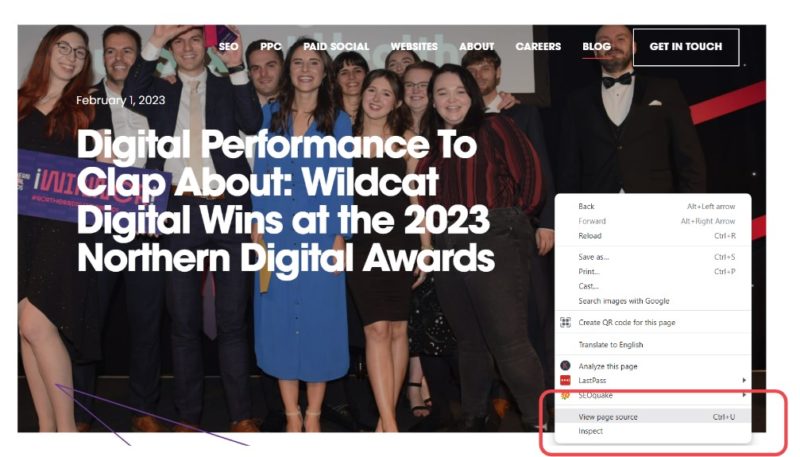A canonical tag tells search engines which page they should prioritise when crawling a website where there are duplicate, or very similar, web pages. They are located within your HTML and are extremely useful for Search Engine Optimisation (SEO) to fix cannibalisation issues, remedy duplicate pages, help your site’s overall ranking performance and more.
So, when you’re met with a website that has multiple canonical tags, how do you audit canonical tags for SEO? When looking at your canonical tags, there are 3 important factors that you need to consider. These are; recording each page that has a canonical tag, ensuring that the tag is placed correctly and directs crawlers to the correct landing page, and checking for any technical issues that are preventing the page from being crawled.
Naturally, we all want our websites to perform to the best of their ability. A website producing duplicate URLs for the same page is a common occurrence that will need to be addressed to ensure that your rankings aren’t penalised. To help guide you through your canonical tag audits, we’ve written this short guide. Simply keep reading to learn more.
If you have canonical tags implemented on your website, it’s important that you regularly audit them to ensure that they are running correctly. Improper use of the canonical tag, or failing canonical tags, can significantly damage your rankings and overall website performance. For example, if your canonical tag directs crawl bots to a URL that has since been redirected, your tag will fail. Changes in your ever-growing website are normal, and a canonical audit is a simple way to ensure that everything is running as smoothly as possible.
The first step in conducting your canonical audit is to find the most practical way to check the status of your existing tags. If you have a short list of existing tags, then you may choose to do this manually. For larger websites, using a software tool to run a site-wide audit is the best and most time-efficient method to ensure everything is running as it should.
To check your tags manually, you simply need to inspect the page. To do this, right click on the page and select ‘View page source’. From here you can use the search feature by pressing ‘Ctrl + F’ to search for ‘canonical’. Your tags (if present) will be highlighted for you to easily locate.


Once your tag is identified, you need to ensure that the tag uses the correct URL (preferably the original page source) and is located in the correct aspect of your HTML, which should be in the <head>. If everything looks good in your HTML, you then need to check the actual page and the content within it. This includes ensuring that your links aren’t broken, and running the URL through Google Search Console to ensure that there are no technical issues that are preventing the page from being crawled.
Alternatively, if you have a large website, or want to explore if any other URLs on your website are facing duplication problems, then using software to inspect your site may be the best way to audit your tags. Here, you can run your website through software such as Screaming Frog, Moz or SiteBulb to identify any issues. Typically, these types of software will be able to detect and report if a page requires a tag added to fix any technical issues, or if an existing tag is broken. This is a preferred method of audit to ensure that no pages on your website are missed.
When you are conducting your site audits, there are a variety of different canonical tag labels that you need to be aware of. We’ve listed all the essential information below:
This identifies that the page has a canonical set.
This page has a canonical tag set and the URL specified within the tag is the same page that has been crawled. Google recommends that we always add a self-referencing canonical to a page when there is no canonical set.
A ‘missing’ label means that this page requires a canonical tag to be set.
If a page is flagged as ‘canonicalised’, then a tag is present that is instructing crawl bots to index a different page that is not the current URL.
Non-indexed canonical warnings imply that the page the tag is directed to is a non-indexable page. This is a technical issue that will need to be resolved.
This is a warning that indicates that multiple pages are tagged to be directed to in the canonical. This will need to be amended to just one targeted URL.
If you do not audit your canonical tags, then you run the risk of technical failures penalising your ranking ability. This could be through pages being unable to index correctly, crawl bots being unable to correctly navigate your website, or duplicate content causing cannibalisation issues on essential landing pages. This is an essential technical skill that those within SEO should learn more about to fix what are extremely common issues.
If you’re having trouble with your canonical tags, let the expert team at Wildcat Digital help. We are an experienced team of SEO experts that are ready to help any website achieve its best potential. Simply explore our website to learn more, or get in touch with us today to receive your free consultation.

Founder
Our founder, Will Hitchmough, worked at a number of high profile Sheffield Digital Agencies before founding Wildcat Digital in 2018. He brings an extensive knowledge of all things related to SEO, PPC and Paid Social, as well as an expert knowledge of digital strategy.
Digital Marketing can be a minefield for many businesses, with many agencies ready to take your money without knowing how to deliver results. I founded Wildcat Digital to deliver digital success to businesses with smaller budgets in a transparent way.

Head of Growth
Rich joined us in May 2024 to head up our growth team. With years of experience helping other agencies to grow, Rich joins us at an exciting time as Wildcat is working on a five-year plan to become one of the biggest agencies in the UK.
Outside of work, Rich is a father to three children, which keeps him very busy! He’s also recently started running again to keep fit and loves a bit of DIY.

Head of Digital
Sarah joined Wildcat in January 2025, bringing over seven years of SEO expertise to the team. With a background in Fashion Communication and Promotion, she has worked both in-house and at agencies, covering a range of digital marketing specialisms before focusing on SEO.
Passionate about all things search, Sarah thrives on helping brands grow their online presence.
Outside of work, she enjoys walking her dog, running, and shopping for vintage clothing.

Office Manager
Amelia joined Wildcat Digital in January 2025, bringing extensive experience in HR, Health & Safety, Facilities Management and IT Support. Previously an Operations Manager at The University of Sheffield, she has a strong background in creating efficient and well-organized work environments.
Specialising in HR, Health & Safety, and Facilities Management, Amelia ensures the Wildcat Digital team has the resources and support needed to thrive. Whether managing office operations, maintaining compliance, or fostering a positive workplace culture, she keeps everything running smoothly.
Outside of work, Amelia loves trying new things, traveling, camping, and walking. She also enjoys socialising and exploring new places with friends and family. Her adventurous spirit and proactive approach make her a valued member of the team.

Client Success Coordinator
Siena joined us in 2023 with a background in sales and digital marketing. She leads on client relationships across the company, ensuring that our customers are happy throughout their journey with us, from their initial consultation through to onboarding and beyond.
Outside of work, Siena enjoys travelling and getting stuck into the local culture. She likes to make the most of her experiences and particularly enjoys watching sunrises and sunsets from beautiful locations around the world.

SEO Account Director
Paul has a strong background in SEO, having previously founded and ran a successful eCommerce business, as well as running a personal blog that achieves an average of 17K users per month. Paul’s knowledge of SEO is extensive, with a strong emphasis on client handling and technical SEO.
Outside of work, Paul enjoys spending time with his family and staying active with weight lifting and combat sports.

Team Lead & Technical SEO Account Manager
With a degree in Computer Science and SEO experience dating back to 2017, Dariusz has a wide range of SEO skills and knowledge. His specialist knowledge of Technical SEO has firmly landed him the title of Wildcat’s Technical Wizard, and he has recently taken on the responsibility of Team Leader for the Panthers Team.
In his spare time, Dariusz loves hiking, experimenting and trying new coffees and loves learning new things. He is currently learning more about CRO and AI and how this could benefit our clients.

Team Lead & Senior SEO Account Manager
With a background in sales, Molly is a natural Account Manager, brilliantly handling any issues that come her way. Having joined us as a Digital Marketing Executive, and working part-time through her final year of University, Molly is a shining example of how hard work pays off. She is now an SEO Account Manager with a particular interest in Content and Client Management.
In her spare time, Molly loves to get out in nature, hiking and exploring the Peak District. She also loves cooking and likes to unwind with a bit of yoga.

PPC Team Leader
Libby joined Wildcat in 2021 as our first PPC hire. With a degree in Digital Media Production, a Master’s in Digital Media Management and previous experience in Social Media Management, Libby hit the ground running and has since climbed the ranks to Senior PPC Account Manager and has a particular interest in the eCommerce sector.
Outside of work, Libby likes gaming, and cooking and likes to keep active by lifting weights.

Senior SEO Account Manager
With a degree in Film and TV production, and a varied career history, Jamie made the move to marketing with a Masters degree in Digital Media Management. He has since worked in SEO at Agencies across Sheffield, before joining Wildcat and working his way up to SEO Account Manager. Jamie has a particular interest in backlinks and Digital PR and has recently gained a client a valuable backlink from Forbes!
In his spare time, Jamie is an avid foodie and loves trying new restaurants and cuisines. He also loves to travel and spent a year travelling to Australia after university.

SEO Account Manager
Jasmine joined Wildcat in 2022 with a strong background in SEO and Account Management. At the time, she was finishing up a Level 4 Apprenticeship in Digital Marketing from the Chartered Institute of Marketing, and has since worked her way up to SEO Account Manager. Jasmine excels at content writing and promotion, and particularly enjoys finding creative ways to join the dots on multi-channel campaigns.
In her spare time, Jasmine volunteers at a charity, helping combat loneliness & social isolation experienced by older neighbours. Outside of Wildcat, she owns a catering company, Savery Grazing, creating delicious grazing tables & platters for a range of events. She also loves skiing and exploring the Peak District.

SEO Account Manager
Thea has a wealth of experience in SEO, having previously worked for other Digital Marketing Agencies in Sheffield. She has a particular interest and skills in Technical SEO, but is more than willing to get stuck in and give anything a go.
Outside of work, Thea spends most of her time with her children, but also loves reading, photography and gardening.

PPC Account Manager
Masilda joined the Wildcat team in October 2024 with over seven years of experience in digital marketing. She specialises in Google Ads, but is also certified in Google Analytics, YouTube Ads, Google Ads for Ecommerce and Apple Search Ads. She has extensive expertise in performance marketing, display advertising, online lead generation and market planning.
In her free time, Masilda likes staying active, cooking, trying new restaurants and exploring new places.

Senior SEO Executive
After spending ten years managing businesses, restaurants, cafes and event spaces across Sheffield, Jon decided to change careers and joined Wildcat as an SEO Executive in 2022. He especially enjoys the client management side of the job, helping them to understand digital marketing and ways in which they can build their business’s presence online.
Outside of work, Jon likes to keep fit with running, badminton and football, and also loves music.

Senior SEO Executive
Andy joined Wildcat in 2023 after starting his digital marketing career in-house for a local Sheffield company. Since joining, he has developed a strong interest in Technical SEO and has strong skills in Account Management.
Outside of work, Andy loves music and plays in a couple of bands. He also enjoys rock climbing, cycling, photography and good food.

Senior SEO Executive
Kezia joined us in July 2024 after completing a CIM Certificate in Digital Marketing and gaining experience in Content SEO at another Sheffield agency.
In her spare time, Kezia loves to get outdoors, bouldering, hiking and travelling.

Senior PPC Executive
Alex joined Wildcat Digital in December 2024 as a Senior PPC Executive, bringing a strong background in Paid Media, Paid Social, and Programmatic advertising. With a degree in Business & Marketing and Google Ads certifications, she has the expertise to craft high-performing campaigns that drive results.
Before joining Wildcat Digital, Alex worked at two leading agencies in Leeds, honing her skills across various digital advertising platforms. Her analytical mindset and strategic approach help businesses maximize their online presence and advertising budgets.
Outside of work, Alex enjoys spending time with her dog, Lola, and going on walks with her dog walking group. She’s also a keen footballer and loves playing five-a-side whenever she gets the chance. Her enthusiasm and team spirit make him a great addition to the Wildcat Digital team.

SEO Executive
Amy joined Wildcat in 2024 with a background in journalism, having worked as a News Editor and Editor-in-Chief at The Sheffield Tab. She is naturally interested in Content SEO and research, so will no doubt prove to be a content power-house.
In her spare time, Amy loves watching crime shows, listening to music and hanging out with her dog, Eddie!

June 30, 2025
Welcome to June’s digital marketing news roundup. There’s been major changes in both PPC and SEO, especially regarding AI. We’ll…
May 30, 2025
If you’ve ever tried searching for a local business or service, the chances are you’ve come across a Google map…

May 20, 2025
Welcome to this month’s digital marketing news roundup! As ever the digital landscape continues to transform at lightning speed, so…